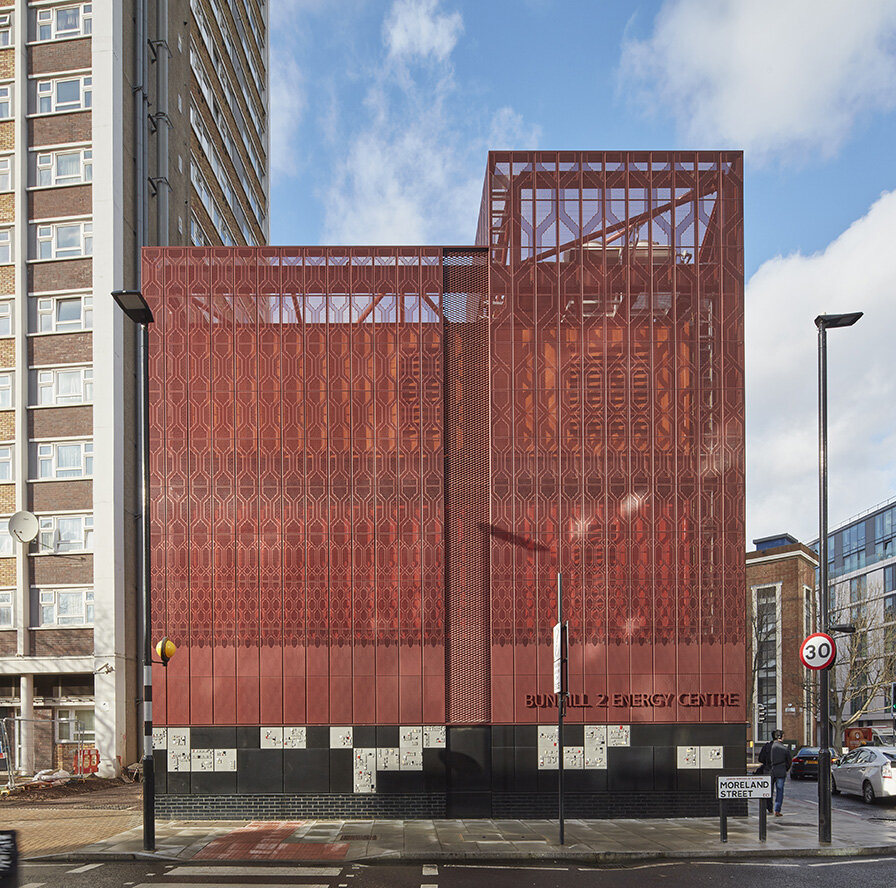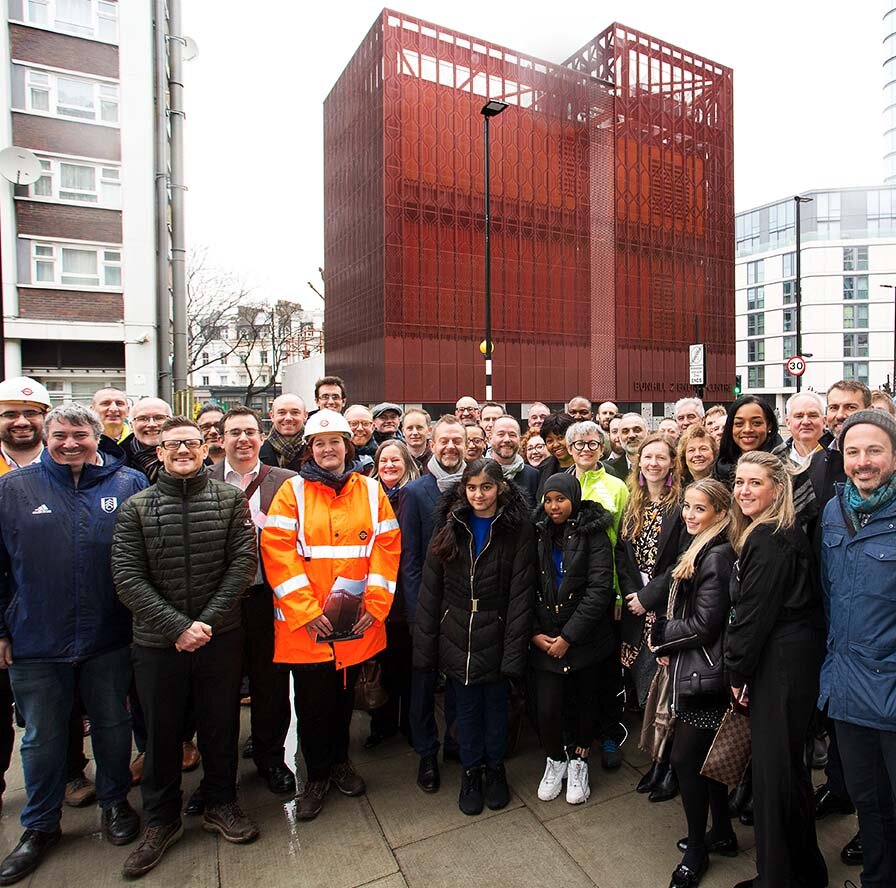The Bunhill 2 Blueprint:
How to get a green community energy project built in your city
The pioneering Bunhill 2 Energy Centre takes waste heat from the London Underground and uses it to warm local homes, classrooms and swimming pools, and all in a proudly distinctive civic structure. This world-first project also provides a blueprint that other councils and cities can use to deliver more affordable, greener energy to their communities.
As the architects, here are our key insights for turning Bunhill 2 from an award-winning local project into a template that can apply to any city in the world, as we all work towards carbon net zero...
Bunhill 2 Energy Centre in Islington is a world-first. To a passer-by it is a striking structure, featuring civic art and complementing the local streetscape. But it is also a pioneering piece of civic heating engineering.
Hidden beneath the street is the lift shaft of the defunct City Road Underground Station, closed to commuters since 1922 but now given new life as the housing for a huge fan that extracts waste warm air from the Northern line tunnels. This air heats water which is pumped through a new 1.5km network of subterranean pipes and provides discounted heating and hot water to Moreland Primary School, Ironmonger Row Baths and Finsbury Leisure Centre, as well as over 800 homes (and with the potential to supply up to 1,400 more). The fan can be reversed to cool the Tube tunnels in the summer, while the state-of-the-art tech also generates cheap, green electricity that powers the communal lighting and lifts of an adjacent tower block.
The project has won the New London Awards Environmental Prize, the RIAI Award for Sustainability, a RIBAJ MacEwan Award Commendation and was a finalist in both the Dezeen Awards and Blueprint Awards.
Opportunities are everywhere
“I’ve set London the target of being carbon-neutral by 2030. It’s an ambition that will require innovative projects like Bunhill to help deliver it.” Sadiq Khan, Mayor of London
Bunhill 2’s successful use of the Underground tunnel network opens up exciting opportunities for the capital. The Greater London Authority estimates there is enough wasted heat in London to meet 38% of the city’s heating demand; and, by expanding district heating networks like Bunhill, this could rise to 63% of demand by 2050.
Yet for us, the most exciting thing about Bunhill 2 is that opportunities to apply the blueprint exist almost everywhere. Any city in the world with an underground train network can replicate the circular heat pump concept. But myriad other possibilities exist to make use of wasted heat and energy: in sewers, tunnels, data centres and more.
The GreenSCIES consortium, funded by Innovate UK, is currently exploring projects including the use of waste heat from heavy and light industry in Birmingham; and from disused mine shafts in Sheffield.
Once eyes are opened to the low-cost, sustainable energy that can be harnessed from the ordinary workings of any city, the sheer scale of the global opportunity becomes clear. These are the kinds of practical innovations that can improve local air quality, combat fuel poverty by making heating more affordable for communities, make energy more efficient by producing it locally to where it is used, and make net zero carbon goals achievable.
GreenSCIES - leading the way towards smarter energy
GreenSCIES (Green Smart Community Integrated Energy Systems) is a consortium with a mission to design a smart energy system that integrates new low carbon energy technologies across heat, power and mobility. Beginning with projects in the London Borough of Islington, it aims to develop a clear path for replication elsewhere in the UK.
GreenSCIES is funded by Innovate UK, part of UK Research and Innovation (UKRI) through the Government’s Industrial Strategy Challenge Fund on Prospering From the Energy Revolution. It is led by London South Bank University and the consortium members include London Borough of Islington, Transport for London, E.ON, Carbon Descent Projects, Grid Edge, Repowering London, Consortio, Silver EMS, Cenex, Hangar 19 and West Midlands Combined Authority.
Cullinan Studio are the architects in the GreenSCIES consortium, with partner Kristina Roszynski sitting on the Management Board leading on Community Engagement.
The Bunhill blueprint: Four insights for delivering successful community smart energy projects
As the architects on Bunhill 2 we gained numerous insights into the challenges of creating a new kind of energy infrastructure in the heart of a city. Every project will of course have its own particular technical, geographical and political challenges – but Bunhill 2 clarified core principles that will apply universally...
1. Start with collaboration
Designing and building Bunhill 2 project was a highly complex process, bringing together parties including civil engineers and specialist District Energy engineers, and needing to meet the various requirements of Islington council, TfL and local residents. The project’s scope and technical ambition grew significantly during the process, with the addition of a gas turbine and reversible fan that directs cooled air back into the Tube system.
Cullinan Studio’s role was to help facilitate between all these parties, coordinating infrastructure, architecture and the community engagement. Collaboration right from the start of a project is advisable in order to maximise efficiency and save time and money.
Wherever they are in the world, community energy projects are going to throw up an array of technical and political challenges that will require innovative solutions, open minds and good relationships. This can only be delivered by architects with expertise in making collaboration work.
2. Prepare for a challenging planning process
Because Bunhill 2 was a world-first (never mind a first for London), the planning process was unusually demanding. There were concerns about the possibilities of noise, light and air pollution, as well as the complexities of the interface with the London Underground – all of which Cullinan Studio had to address directly with Planners.
Energy centres and their district heating infrastructure are a new kind of network to our cities, which means that the planning process in any city will almost certainly be more challenging than for other projects. The role of architects is to take the lead in securing the required approvals.
3. Work with local residents
Getting local residents on board isn’t just necessary to support a successful planning process. City energy centres involve making use of land in densely-populated, intricate urban areas – so it is essential to fully understand and respond to the views of the people who will be directly affected.
For the Bunhill 2 project Cullinan Studio provided community engagement, running workshops with local residents and incorporating their feedback into the design process. Participation of resident communities in the design of Bunhill 2 augmented a sense of local ownership and pride.
4. Make it part of a streetscape that locals can be proud of
Bunhill 2 was originally conceived as an engineering project, but its scale and location meant it would be encountered as a building. As such it was critical that it was consciously designed to make a considered contribution to the streetscape and the character of the locality.
The site was previously a neglected but prominent site at a junction on City Road, a shabby brick substation smothered in fly-postings with forlorn left-over patches of space between. It is now a striking addition to the neighbourhood – a structure of beauty and interest that echoes existing building lines yet redefines the street corner. Terracotta tiles and vitreous enamel steel reference the materials of the Underground, while tessellating across the base are cast aluminium relief panels, designed by artist Toby Paterson to take inspiration from the local estates the energy centre serves. The perforated pattern in the cladding even ebbs and flows in response to the varying degrees of ventilation required for the equipment behind.
Smart community energy centres should be more than merely functional: they provide an opportunity for architects to revitalise neglected sites and design something that enhances the city and makes people proud.
Bunhill 2 is a world-first but it should not be a one-off. Its success could be replicated by every council in London and potentially by any city in the world, delivering greener, affordable energy to their communities as we all work towards net zero carbon.
As the architects behind Bunhill 2, Cullinan Studio are uniquely positioned to provide insights and expertise on future smart community energy centres. To discuss, contact Kristina Roszynski.





